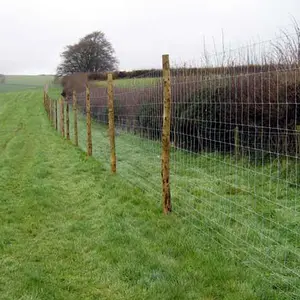
Cattle Fence Field Wire Mesh cattle livestock farming Game Fence for Cattle fence livestock raising animal rearing
















The term cattle fence encompasses a range of barriers used in agricultural settings to contain and protect livestock, particularly cattle. These fences serve not only to confine cattle within designated areas but also to safeguard them from external threats and prevent them from straying into hazardous zones. The design and construction of cattle fences take into account the behavioral patterns and physical attributes of cattle, ensuring both the animals' welfare and the ease of farm management.
Cattle fencing can be constructed from various materials, each offering distinct advantages. The traditional cattle stock fencing is often made from woven wire, providing a balance between flexibility and strength. For those requiring more robust solutions, 16ft cattle panel fences made from heavier gauge steel are a popular choice. In contrast, cattle fence wire offers a more cost-effective option, while electric fence for cattle introduces a psychological barrier, deterring cattle from testing the fence boundaries through a mild electric shock.
Cattle fences are versatile and find applications beyond the simple containment of livestock. They are integral to the management of grazing patterns, can be used to create corrals for veterinary procedures, and are essential in the design of secure cattle handling facilities. Features such as durability and resistance to environmental factors are critical, with options like powder coated and hot dip galvanized finishes enhancing the longevity of the fence against corrosion and wear.
Implementing an effective cattle fencing system offers numerous advantages. It minimizes the risk of cattle escaping and causing accidents or damage, ensures the safety of the animals from predators, and facilitates the efficient use of pasture by controlling the movement of the herd. Additionally, fences like the cattle panel fence or bull panel fence provide clear property boundaries, which is crucial in preventing disputes with neighboring landowners.
Selecting the appropriate cattle fence requires consideration of several factors, including the terrain, the size of the area to be fenced, and the specific needs of the cattle breed. For instance, cattle gates are necessary for providing access points, and the use of cow fence wire may be suitable for flat terrains, whereas more rugged landscapes might necessitate a tractor supply livestock panel for added sturdiness. The choice of an electric fence for cows can be particularly effective in deterring bulls or more aggressive cattle from challenging the fence.
In conclusion, cattle fences are a fundamental component of livestock management, ensuring the safety and security of cattle while facilitating efficient farm operations. By understanding the various types, materials, and applications of cattle fencing, agricultural professionals can make informed decisions that align with their specific requirements and conditions.